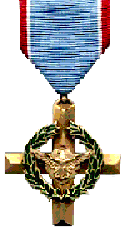
Capt Willard Marion Collins
AC-47D Spooky Gunship Crewmember

Air Force Cross
WILLARD MARION COLLINS
Captain, U.S. Air Force
4th Air Commando Squadron
Date of Action: March 09, 1966
Citation:
The Air Force Cross is presented to Willard Marion Collins,
Captain, U.S. Air Force, for extraordinary heroism in connection with military operations against an opposing armed force near A Shau, Republic
of Vietnam, on 9 March 1966. On that date, Captain Collins was Aircraft Commander of an AC-47 that was scrambled in defense of a Special Forces
camp which was under heavy attack by hostile forces. Arriving over the area, Captain Collins attempted to locate the camp which was surrounded
by mountainous terrain in a narrow valley and obscured by heavy clouds. He made two attempts to penetrate into the valley but was forced to
withdraw. On his third attempt, he entered the valley at tree top level, and managed to locate the camp. With complete disregard for his personal
safety, and fully aware of his aircraft's vulnerability to ground fire, Captain Collins maneuvered into position. He made two firing passes
against the hostile forces. It was on the second pass that both engines exploded from the impact of ground fire. Demonstrating superb
airmanship and skill, Captain Collins successfully crash landed his battle torn aircraft. After landing, Captain Collins rallied his crew and attempted to establish defense positions away from the aircraft. He then discovered that one crew member was injured and could not be moved, and he refused to abandon the aircraft for more favorable defensive positions; instead he established a perimeter defense of the aircraft until rescue helicopters arrived. Although attacked by hostile forces in the area, Captain Collins continuously fought off his attackers enabling three of his crew members to be rescued. The valuable minutes which he gave his crew, and for which he paid the supreme sacrifice was directly responsible for their rescue. Through his extraordinary heroism, superb airmanship, and aggressiveness in the face of hostile forces, Captain Collins reflected the highest credit upon himself and the United States Air Force.
Another account of the events 9 March 1966.
On 9 March 1966, Capt. Willard M. Collins, pilot; Lt.
Delbert R. Peterson, co-pilot; Capt. Jerry L. Meek, navigator; SSgt. John G. Brown, flight engineer; SSgt. James Turner, Jr., aerial gunner
and SSgt. Robert E. Foster, aerial gunner; comprised the crew of a C47 gunship, call sign "Spooky 70," that departed DaNang Airfield on a close
air support mission for the A Shau Special Forces Camp, Thua Thien Province, South Vietnam.
At 1300 hours, when the gunship was approximately 2 miles south of the Special Forces camp, Capt. Collins initiated a left hand turn to position
the aircraft for a firing pass. At the same time the enemy opened up with anti-aircraft artillery (AAA) fire and hit the C47 several times in the
right engine. Capt. Collins feathered the #1 engine and notified the crew they "were going in." After they crash landed, the crew got out,
surveyed the damage and collected their survival equipment and weapons.
SSgt. Foster was injured in the crash and Lt. Peterson began first aid on him. At the same time Capt. Collins began working the survival radio.
Capt. Meek loaded all the M16s and set up a perimeter defense outside the aircraft. About 10 minutes later, Capt. Meek was shot and wounded by a
Viet Cong (VC) guerrilla who was closing on the downed aircraft.
The pilot of an L19 Bird Dog Forward Air Controller (FAC) aircraft spotted the aircraft and crew through the dense jungle and called in A1
Skyraiders to provide air cover for the downed aircrew.
Capt. Meek told Lt. Peterson they needed a sentry at the rear of the airplane because it was a blind spot. Delbert Peterson put on his survival
vest and crawled around past the tail into the undergrowth with his M16.
Before the Skyraiders could make a pass, the right side of the C47 was raked with enemy machine gun fire killing SSgt. Foster outright and mortally
wounding Capt. Collins. Capt. Meek called out to Lt. Peterson and SSgt. Brown. John Brown acknowledged he was all right, but there was no response
from Delbert Peterson.
At approximately 1520 hours, search and rescue helicopters arrived on site and made a circular pass over the crash site. While one descended to a
ground hover approximately 25 feet away from the nose of the C47, the other remained overhead. Capt. Meek ordered SSgt. Brown to make a run for the
helicopter. SSgt. Turner, who had been on the inside of the aircraft, kicked the remnants of the emergency exit door out of the right side.
John Brown, James Turner and Jerry Meek all made it to the rescue helicopter at the same time. As it lifted off the ground, the crew and passengers
searched the area around the C47 for Delbert Peterson, but none saw any trace of him.
About 20 minutes after the three crewmen were rescued, a Special Forces ground team arrived at the crash site. They found the bodies of Capt. Collins
and SSgt. Foster where they had fallen near their aircraft. However, during their search, which included the area in and around where the co-pilot
was last seen, they could find no sign of Lt. Peterson. Further, they found blood spots or blood trails leading away from the crash site.
Because of the heavy enemy presence in the area, the Special Forces team was unable to bring the bodies of Willard Collins and Robert Foster out
with them. Willard Collins and Robert Foster were immediately listed Killed in Action/Body Not Recovered. Because there was a strong probability
Delbert Peterson was captured, he was listed Missing in Action. The location of loss placed the gunship 10 kilometers north of the A Shau Valley
and 2 miles south of the Special Forces Camp they were to provide
air support for.